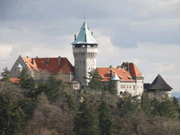 First written documents about the existence of Smolenice date back to the 13th century, although its origin is as ancient as the Neo-Feudalism. Several aristocratic families had been the landlords there – for instance, in 1388 King Sigmund had issued a Deed of Donation to give Smolenice to Chieftain Ctibor of Ctiborice. In 1438, Count George from Pezinok and Svaty Jur became the new landlord there.
First written documents about the existence of Smolenice date back to the 13th century, although its origin is as ancient as the Neo-Feudalism. Several aristocratic families had been the landlords there – for instance, in 1388 King Sigmund had issued a Deed of Donation to give Smolenice to Chieftain Ctibor of Ctiborice. In 1438, Count George from Pezinok and Svaty Jur became the new landlord there.
In the 15th century the importance of Smolenice increased considerably, because a castle was built there which became the centre and seat of the Smolenice estate. Early in the 16th century, Smolenice had been gained by the Orszagh family. In 1777, Jan Palffy takes the Smolenice estate as pawn. The Palffy family did not live at the castle, which had decayed considerably during the life of Kristof III, the last of the Erdödy family – they lacked money for maintenance. The decay was complete during the Napoleon Wars – the main castle building and the tower had burnt down.
Construction of the Smolenice Castle of today had been started early in the 20th century by Jozef Palffy Jr., the landlord of Smolenice and Dobra Voda estates. First work on the fortification walls started in 1887 already on the bastions. Bastions from the old castle were preserved, with height extension and new roofing. The Count Palffy had built the castle at his own expense according to design by the architect Jozef Hubert. During World War 1, the construction was interrupted; provisional adaptation of some rooms was made and archiv of the Palffy family was located there. The construction was not resumed before the end of World War 2. In 1945 the Castle became the property of the State; it was taken over by the Slovak National Council who decided to have their summer-house there. The castle was finished and furbished and handed over to the Slovak Academy of Sciences on 26 June 1953 to become a representative place for meetings of scientists from worldwide.
 The village of Smolenice with the well-known Smolenice Castle is situated at the foot of Male Karpaty mountains, 60 km northwest from Bratislava. The castle shelters the Congress Centre of the Slovak Academy of Sciences (CC SAS). Each year, numerous international congresses and symposiums with international attendance take place here, organised by scientific institutions of the SAS. In the CC SAS 82 beds are available (in single-, double- and three-bed rooms). The representation interior offers interesting views outside. In the restaurant premises, 120 seats for catering are available. The Congress Room has 90 seats. Adjacent English park, well included into
mountain forest edge, offers numerous possibilities for walking to the visitors. The Driny Stalactite Cave, only at 3 km distance from the castle, will certainly please the visitors by its remarkable beauty.
The village of Smolenice with the well-known Smolenice Castle is situated at the foot of Male Karpaty mountains, 60 km northwest from Bratislava. The castle shelters the Congress Centre of the Slovak Academy of Sciences (CC SAS). Each year, numerous international congresses and symposiums with international attendance take place here, organised by scientific institutions of the SAS. In the CC SAS 82 beds are available (in single-, double- and three-bed rooms). The representation interior offers interesting views outside. In the restaurant premises, 120 seats for catering are available. The Congress Room has 90 seats. Adjacent English park, well included into
mountain forest edge, offers numerous possibilities for walking to the visitors. The Driny Stalactite Cave, only at 3 km distance from the castle, will certainly please the visitors by its remarkable beauty.
Opposite to the castle – on adjacent edge of the mountain ridge, one can visit fortified mansion from the 5th century B.C. via marked path (rather difficult to walk). The district town of Trnava with its well-known Baroque sacral monuments can be reached at 20 km distance. Upon request, the CC SAS staff are ready to ensure folk group and/or classical music performances, historical castle games program (historical sword-play, falconers), as well as to offer the products of well-known ceramics manufacture Majolica from Modra, castle wine tasting and other activities to improve the social level of the events. CC SAS is ready to provide for comfort and recovery after scientific events to its guests. Within this sense, the Centre serves to all its guests, thus facilitating international integration.










